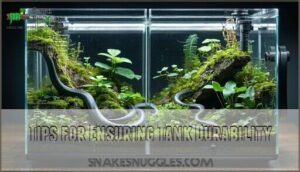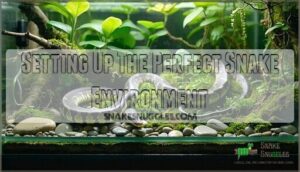This site is supported by our readers. We may earn a commission, at no cost to you, if you purchase through links.

Size matters, so match the tank to your snake’s length, giving them plenty of space to stretch and snooze.
Sturdy glass, PVC, or melamine resists escapes and lets you keep an eye on your reptile’s antics.
Good airflow, stable temperatures, and just-right humidity create the Goldilocks zone your snake craves.
Secure lids are non-negotiable—these Houdinis love to explore.
Ready to upgrade? Next up, you’ll uncover expert tips to make your snake housing tank the best on the block.
Table Of Contents
- Key Takeaways
- Choosing The Right Tank Size
- Key Features for a Snake-Friendly Environment
- Tank Materials and Durability Considerations
- Setting Up The Perfect Snake Environment
- Maintaining and Upgrading Your Snake Tank
- Frequently Asked Questions (FAQs)
- What size tank does a house snake need?
- What type of housing does a snake need?
- Is a 40 gallon tank big enough for a corn snake?
- What not to put in a snake enclosure?
- How often should I clean my snakes water bowl?
- Can I house multiple snake species together safely?
- What are the signs of a stressed or sick snake?
- How do I handle a snake thats escaped its tank?
- Can I use live plants in my snakes tank safely?
- Can snakes be housed together in the same tank?
- Conclusion
Key Takeaways
- Match your tank size to your snake’s length and activity so it has enough room to stretch, hide, and grow.
- Choose sturdy materials like glass or PVC with escape-proof lids—snakes are expert escape artists.
- Control ventilation, temperature, and humidity to keep your snake healthy and stress-free.
- Clean and inspect your setup regularly, and be ready to upgrade as your snake grows.
Choosing The Right Tank Size
Picking the right tank size is essential for your snake’s health, as it needs space to stretch, hide, and grow.
You’ll want to match the enclosure to your snake’s length, girth, and activity level for safe and comfortable living, ensuring the snake has enough room to grow.
Measuring Your Snake’s Length and Girth
For accurate snake housing, measuring your snake’s length and girth is key to ensuring the right tank size.
Keep these important details in mind:
- Measuring accuracy will affect how comfortable your snake feels.
- Different snake species have their own quirks.
- Snake growth stages may surprise you.
- Girth’s importance lies in preventing cramped corners.
- Length variations impact floor space.
- Monitoring changes prepares you for upgrades.
Optimal sizing considers snake movement needs.
Focus on consistency for your snake’s safety, as measuring accuracy and optimal sizing are crucial for a comfortable environment.
Calculating The Ideal Tank Volume
Now that you’ve measured your snake’s length and girth, it’s time for some quick math.
Tank volume isn’t guesswork—use about 2/3 to 1 square foot of floor space per foot of snake length. This method guarantees your slithery friend has wiggle room as it grows.
————:
———-:
————:
Factors Affecting Tank Size Choice
Think beyond tank volume—snake tank size hinges on more than just snake length.
Factor in your pet’s growth stage, activity level, and species needs. A slithery explorer needs more room than a shy lurker.
Tip: plan for future upgrades to cut down on stress later!
- Species needs
- Growth stage
- Snakes activity
- Stress reduction
Popular Tank Sizes for Common Pet Snakes
No two snakes are alike, so pick your snake tank size to fit your buddy’s species and growth stage.
Ball Pythons start small but need a 40-75 gallon reptile enclosure as adults.
Corn Snake needs range from 10-gallon juvenile tanks to larger snake cages.
King Snake enclosure and Milk Snake volume both land near 30-40 gallons for adults.
For adult ball pythons, a minimum 48" enclosure is recommended to ensure their comfort and proper growth.
Key Features for a Snake-Friendly Environment
You’ll get the best results by making sure your snake’s tank has good airflow, stable heat, steady humidity, proper lighting, and secure lids.
These features support your snake’s health and help prevent escapes, making the environment both safe and comfortable.
Ventilation Systems and Air Exchange
With the right tank picked, let’s keep your snake breathing easy. Tank ventilation isn’t just about fresh air; it’s about smart airflow methods, humidity control, and serious mold prevention.
Here’s what to plan for in your reptile enclosure or snake habitat:
- Exchange inside air every 1-2 hours to avoid stagnant, unhealthy space.
- Install screen tops, mesh, or creative DIY vents for balanced tank ventilation.
For DIY solutions, consider using reptile enclosure insert vents designed for easy installation. Position vents for steady air flow and perfect humidity levels suited to your snake, ensuring a healthy environment with proper ventilation and humidity control.
Temperature Control and Gradient Options
Staying on top of temperature control keeps your snake healthy and stress-free.
Always use a solid heating system like a heat mat, paired with thermostat control—digital or pulse-proportional works best.
Create a temperature gradient by placing heat sources on one end and monitoring both basking spots and ambient areas.
Consider snake heat mat options for ideal heating. This gradient importance lets your snake move around to find comfort.
Humidity Levels and Maintenance
After dialing in your tank’s temperature, focus on snake tank humidity.
Use Humidity Monitoring with a hygrometer to keep levels between 30-60%. Consider using a reliable snake hygrometer to maintain proper levels.
Mist the enclosure regularly for proper Misting Techniques, but watch out for moldy substrate. If humidity drops or rises too much, you could face Shedding Issues or unwanted Mold Prevention headaches—so don’t skip snake tank maintenance and adjust substrate moisture as needed.
Lighting Choices for Visual and UVB Stimulation
After you’ve balanced humidity, let’s brighten things up with snake tank lighting.
UVB Importance can’t be overstated—it keeps bones healthy and supports Plant Growth if you have live décor.
Try these lighting options:
- Use UVB lamps (T5, T8, compact fluorescents) for proper Lighting Spectrum.
Consider snake UVB options for ideal reptile health.
- Add Heat Lamps to maintain basking spots.
- Set a regular diurnal cycle with a 10–12 hour light cycle.
Secure and Escape-Proof Tank Designs
After sorting out lighting needs, let’s focus on snake tank security.
Don’t underestimate your snake’s knack for escape—an escapeproof lid with tight Lid Security and reliable Latch Mechanisms is key.
Pick secure enclosure materials with solid Material Strength to resist pushes or warping.
Watch for Design Flaws—tiny gaps can spell escape prevention failure.
Proper ventilation and secure designs mean your snake stays safe inside.
Tank Materials and Durability Considerations
When choosing your snake’s tank, think about how long each material will last through years of cleaning and heat changes.
Knowing the strengths and weaknesses of glass, plastic, wood, and melamine helps you pick a safe, sturdy home that won’t fall apart.
Glass, Acrylic, and PVC Tank Options
Now that you understand what makes a tank snake-friendly, you’re probably eyeing materials. When choosing between glass tanks, acrylic tanks, and PVC tanks, remember: each material has quirks.
Glass durability is legendary, but the weight might surprise you. Acrylic scratches come quickly—one curious snake can leave its mark. PVC tanks are loved for custom builds and easy lifting, but keep an eye on PVC toxicity if you’re a DIY enthusiast.
- Glass tanks show off your snake and clean up nice.
- Acrylic tanks lighten the load, but mind the scratches.
- PVC tanks keep costs low and are easy on your back.
- Assess material costs and tank durability.
- Customize if you want control over your tank’s design.
Wooden and Melamine Tank Choices
When you lean into wooden tanks, you get that woodsy vibe, but be ready for regular checks against wood rot and constant humidity control.
Melamine tanks shine for DIY construction and Melamine Sealing, offering easy cleaning and fair cost comparison, but can dent on durability.
Here’s a quick side-by-side:
| Feature | Wooden Tanks |
|---|---|
| Look | Natural, rustic |
| Durability | Needs upkeep |
| Humidity Control | Can be tricky |
| Rot Resistance | Needs sealing |
| Cost Comparison | Moderate |
Pros and Cons of Each Material
After weighing wooden and melamine tanks for style, it’s time to size up other materials.
Glass Durability gives clear views but can be heavy and pricey. Acrylic tanks make lifting easy, though Acrylic Scratches and higher cost are common.
PVC tanks resist water, but cheap versions risk PVC Toxicity. Wooden tanks look great but watch for Wood Rot, while Melamine Cleaning is straightforward though durability may lag.
Remember that proper ventilation, as well as secure tank lids, are essential for any enclosure.
Weigh these four tank material traits:
- Durability
- Cost
- Cleaning ease
- Safety
Tips for Ensuring Tank Durability
A durable snake tank starts with smart choices and attention to detail.
Don’t let a weak joint or mystery creak turn your reptile’s home into a hazard.
Follow these four key tips:
- Inspect all seams and corners for stress points—use extra silicone for Joint Reinforcement and proper Sealing Techniques to keep leaks at bay.
- Choose tank material wisely; glass is sturdy but needs scratch prevention, while plastics can warp if overheated.
- Distribute weight evenly. Overloading one side can cause trouble over time.
- Always use secure enclosure materials. Research snake tank materials to match your species’ needs and boost snake tank durability.
Key Considerations
When building or choosing a snake tank, it’s essential to consider the needs of your species and the potential risks associated with a poorly designed or constructed enclosure.
Setting Up The Perfect Snake Environment
To set up the perfect snake environment, start by arranging the tank with proper substrate, hiding spots, and a clean water dish.
You’ll also need to add controlled heat sources, UVB lighting, and monitor the conditions to keep your snake healthy.
Creating a Naturalistic Layout
A naturalistic layout brings your snake’s tank to life, making your pet feel right at home.
Transform your snake’s home into a living landscape, inviting natural wonder and comfort into every corner.
Start with live plants—choose easy-to-care-for types like air plants or succulents that boost oxygen and create shelter.
Rock formations add hiding places and a sense of adventure; just verify rocks can’t shift and trap your snake.
Enhance the space with a natural background, which reduces stress and makes the tank more visually appealing.
A shallow water dish or a simple misting system helps with humidity control.
Don’t forget sturdy branches for climbing and basking.
An engaging snake tank design keeps your reptile healthy and curious.
Adding Substrate, Water, and Hiding Places
With your tank layout ready, it’s time to focus on your snake’s comfort. Picking the right snake tank substrate—like aspen shavings or cypress mulch—helps mimic naturalistic design and supports burrowing needs.
Place about 1-2 inches for safe, injury-free digging. A sturdy water dish is key; choose one that won’t tip when your snake gets curious.
Hiding variety matters, too—combine rocks, plants, or store-bought hides for secure retreats. Understanding the importance of substrate for snake health is vital for their well-being.
- Substrate types: aspen, cypress mulch
- Water dish: stable and shallow
- Hiding places: rocks, commercial hides, plant decor
Integrating Heat Sources and UVB Lighting
With your substrate, water, and hides in place, it’s time to focus on heating systems and UVB lighting.
Set up a basking spot by placing a heat lamp 6–8 inches above a sturdy hide or flat stone. This Basking Spot Design lets your snake soak up warmth—no campfire stories needed.
For a safe Temperature Gradient Setup, use a thermostat to hold one end warmer while the other stays cooler. Always deploy the Heat Mat Safety rule: plug heat mats into thermostats, never straight into the wall.
For your UVB Placement Guide, choose bulbs made for reptiles, install them 12–18 inches above the floor, and replace every 6–8 months.
Lighting Cycle Automation is easy with outlet timers—your snake’s daylight and darkness will stay on schedule. Check temperatures daily; adjust heat or lighting as your snake’s needs change.
Cycling and Monitoring Tank Conditions
Just finished with heat and UVB setups? Now, let’s make sure your tank is safe long term by keeping conditions stable.
Stay on top of tank cycling and water parameters to prevent trouble down the line.
- Track ammonia levels weekly.
- Follow the nitrogen cycle.
- Monitor bacterial growth.
- Apply effective disinfection methods.
- Inspect tank conditions regularly.
Maintaining and Upgrading Your Snake Tank
You’ll need to regularly clean, disinfect, and inspect your snake tank to keep your pet healthy and stress-free.
Upgrading features or tank size as your snake grows guarantees the best living conditions and supports natural behaviors.
Cleaning and Disinfecting The Tank
Hygiene keeps your snake healthy—think of cleaning as preventative medicine, not just a chore.
A clean tank is your snake’s best defense against hidden health risks—keep it spotless for a happy, thriving pet.
Remove waste daily, wipe down surfaces, and tackle Substrate Cleaning weekly.
Scrub the Water Dish with hot water, and use reptile-safe Disinfectant Choices to kill germs, helping with Preventing Bacteria.
Regular tank cleaning and snake tank cleaning build good tank maintenance habits, minimizing health risks through consistent cleaning frequency and proper disinfecting.
Replacing and Updating Tank Components
Over time, your snake tank equipment can wear out or lose effectiveness, making routine tank maintenance and upgrades essential.
Keep a close eye on filter replacements, basking bulbs, and hiding upgrades. Check all snake tank accessories and water bowls for cracks or grime. Replace heating elements every 6–12 months, UVB lights every 6–8 months, and decorations as needed.
To maintain a healthy environment, it’s important to choose the right substrate based on the snake’s habitat needs.
- Peace of mind watching your snake thrive
- Pride in a spotless tank after cleaning
- Relief from preventing hidden health risks
Upgrading to a Larger or Better Tank
Growth spurts or behavioral changes often signal it’s time for snake tank upgrades.
Check tank limitations—your snake deserves an enclosure size that matches its enrichment needs.
When planning future-proofing, factor in tank upgrade costs, available space, and improved heating.
Here’s a quick snake tank size guide:
| Factor | What Matters | Pro Tip |
|---|---|---|
| Tank Limitations | Snake’s Length | Use a reliable tank size guide |
| Enrichment Needs | Decor/Space | Add hides and climbing spots |
| Heating/Lighting | Even Coverage | Upgrade as tank grows |
Common Issues and Troubleshooting Tips
Moving on from tank upgrades, snake tank troubleshooting is like detective work for your pet’s safety.
Watch for these common snake tank issues and solutions:
- Snake escape—Double-check lid security, latch strength, and patch gaps for solid Escape Prevention.
- Moldy substrate—Swap out damp bedding and increase airflow to avoid Substrate Impaction and scale rot.
- Incorrect humidity—A sticking thermostat or wrong hygrometer throws off moisture, so recalibrate often.
- Odd shedding or abrasions—Monitor for Shedding Problems and Abrasions/Scale Rot.
Consult a reptile vet if issues linger, ensuring the best care for your pet through proper troubleshooting.
Frequently Asked Questions (FAQs)
What size tank does a house snake need?
Picture a snake stretching out like a curious shoelace—your tank should match its length, with the floor at least as long as your snake.
A 20-40 gallon tank fits most house snakes, depending on their adult size.
What type of housing does a snake need?
You’ll need a secure, escape-proof enclosure with proper ventilation, temperature control, and hiding spots.
Use a sturdy material like glass or PVC.
Add a snug hide, water dish, and safe substrate—snakes appreciate a cozy, natural setup.
Is a 40 gallon tank big enough for a corn snake?
A 40-gallon tank fits a young corn snake just fine, but adults really stretch out—literally!
For lifelong comfort, aim for at least a four-foot-long enclosure.
Remember, your corn snake loves to slither and explore!
What not to put in a snake enclosure?
Like tossing shoes in a dryer, sharp décor, cedar bedding, sticky tape, and strong chemicals can stress or injure snakes.
Skip live prey, loose wires, or toxic plants—stick to safe, simple, and snake-approved items.
How often should I clean my snakes water bowl?
Change your snake’s water bowl daily to stop bacteria and slime before they start.
If your snake soaks or makes a mess, swap it out right away.
Clean with hot water and mild soap for best results.
Can I house multiple snake species together safely?
Mixing snake species sounds thrilling—like hosting a peace summit for natural-born rivals.
But snakes vary in habitat, diet, and temperament. You’ll risk stress, aggression, or disease.
For real harmony, house each species in its own enclosure.
What are the signs of a stressed or sick snake?
If your snake’s hiding more than usual, refuses food, breathes with an open mouth, or shows swollen eyes or scales, it’s waving a red flag.
Don’t ignore strange poop, wheezing, or unusual skin color changes.
How do I handle a snake thats escaped its tank?
Did you know over 70% of escaped snakes hide within 10 feet of their tank?
Stay calm, check warm, dark spots—behind furniture or appliances.
Gently use a towel to guide your snake. Never grab quickly or panic, and remember to stay calm.
Can I use live plants in my snakes tank safely?
Absolutely, you can use live plants in your pet’s enclosure if you pick non-toxic species and wash them well.
Plants boost humidity, look great, and offer hiding spots.
Just check temperature and lighting needs match your snake’s care.
Can snakes be housed together in the same tank?
You’ll run into trouble if you keep two snakes in one tank—territorial fights, disease spread, or even a quick snack gone wrong.
Each snake needs its own secure home for safety, health, and peace of mind.
Conclusion
Structure, safety, and security set your snake housing tank apart.
By choosing the right size, material, and features, you’ll give your snake a haven that’s healthy and happy.
Remember to monitor conditions, clean regularly, and update parts as needed.
Even master escape artists find it tough to outsmart modern tank designs.
With your attention to detail, your snake housing tank becomes more than shelter—it’s a space where your reptile can truly thrive and show natural behaviors.
- https://www.reptilerescuecenter.org/caresheets/ballpython/
- https://www.petmd.com/reptile/ball-python-care-sheet
- https://reptifiles.com/ball-python-care-guide/ball-python-terrarium-size-lighting/
- https://www.reddit.com/r/snakes/comments/3fx9b4/tank_size_for_a_ball_python/
- https://cornsnake.net/pages/housing

















